| dc.description.abstract | Dispersion of immiscible fluids in a Couette device, in which the inner cylinder rotates whereas the outer one is immobile, is modelled. Two different modelling approaches are employed. The 1st approach is based on solving a one-dimensional Advection-Diffusion-Population Balance equation. An influence of upper and bottom Couette device covers (the so-called end effect) is ignored in this case. The Prandtl mixing length model of turbulence, employed for modelling of a Couette flow field, allows obtaining an analytical expression for calculation of the energy dissipation rate distribution across Couette device gap. Fixed Pivot method is employed for numerical solution of the population balance equation. The 2nd approach is based on the CFD-population balance AMuSiG method, recently implemented into the STAR-CCM+ code of Siemens PLM Software. The Reynolds stress turbulence model along with the Daly & Harlow transport model are employed for modelling two-dimensional axisymmetric flow field in a Couette device. In the present work, modelling is limited to only droplet breakup; i.e., only non-coalescing droplets are considered. A modified droplet breakup model of Coulaloglou and Tavlarides (1977) is employed for all the computations. Computed droplet size distributions are compared with those obtained in a laboratory Couette device of a relatively small height that is a cause of the significant end effect. Dispersion of water droplets in silicone oil is studied. Coalescence is suppressed by a surfactant. The experimental droplet size distributions are reasonably well fitted by both the models employed. The most significant advantage of the 3-D computations over the 1-D modelling is accounting for the end effect, that in its turn affects both velocity and energy dissipation rate distributions over the Couette device gap. Also, to better fit the experimental data, a weak coalescence was formally introduced into the 3-D computational code. | nb_NO |
